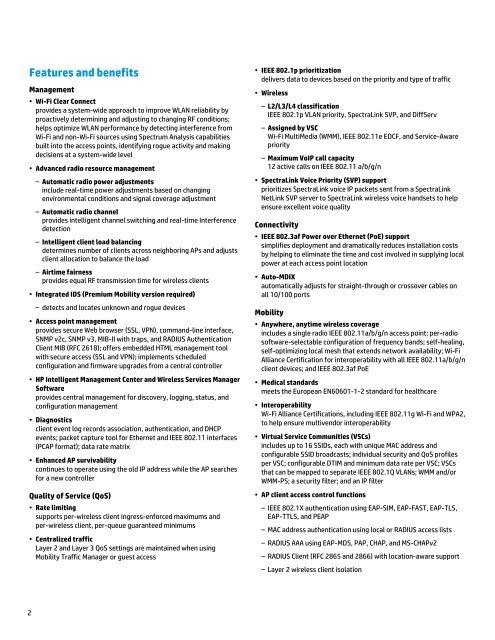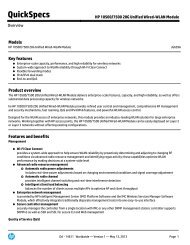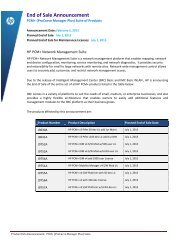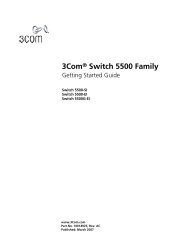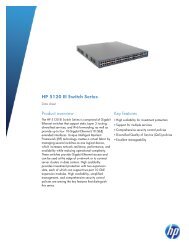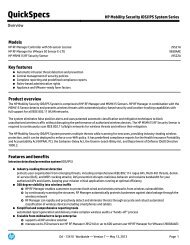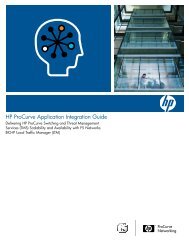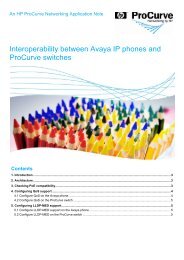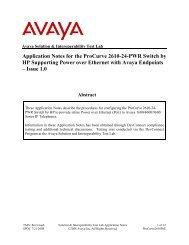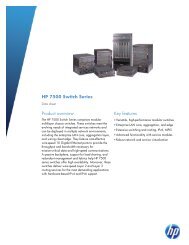HP MSM-802.11n Access Point Series - HP Networking
HP MSM-802.11n Access Point Series - HP Networking
HP MSM-802.11n Access Point Series - HP Networking
Create successful ePaper yourself
Turn your PDF publications into a flip-book with our unique Google optimized e-Paper software.
Features and benefits<br />
Management<br />
• Wi-Fi Clear Connect<br />
provides a system-wide approach to improve WLAN reliability by<br />
proactively determining and adjusting to changing RF conditions;<br />
helps optimize WLAN performance by detecting interference from<br />
Wi-Fi and non-Wi-Fi sources using Spectrum Analysis capabilities<br />
built into the access points, identifying rogue activity and making<br />
decisions at a system-wide level<br />
• Advanced radio resource management<br />
– Automatic radio power adjustments<br />
include real-time power adjustments based on changing<br />
environmental conditions and signal coverage adjustment<br />
– Automatic radio channel<br />
provides intelligent channel switching and real-time Interference<br />
detection<br />
– Intelligent client load balancing<br />
determines number of clients across neighboring APs and adjusts<br />
client allocation to balance the load<br />
– Airtime fairness<br />
provides equal RF transmission time for wireless clients<br />
• Integrated IDS (Premium Mobility version required)<br />
– detects and locates unknown and rogue devices<br />
• <strong>Access</strong> point management<br />
provides secure Web browser (SSL, VPN), command-line interface,<br />
SNMP v2c, SNMP v3, MIB-II with traps, and RADIUS Authentication<br />
Client MIB (RFC 2618); offers embedded HTML management tool<br />
with secure access (SSL and VPN); implements scheduled<br />
configuration and firmware upgrades from a central controller<br />
• <strong>HP</strong> Intelligent Management Center and Wireless Services Manager<br />
Software<br />
provides central management for discovery, logging, status, and<br />
configuration management<br />
• Diagnostics<br />
client event log records association, authentication, and DHCP<br />
events; packet capture tool for Ethernet and IEEE 802.11 interfaces<br />
(PCAP format); data rate matrix<br />
• Enhanced AP survivability<br />
continues to operate using the old IP address while the AP searches<br />
for a new controller<br />
Quality of Service (QoS)<br />
• Rate limiting<br />
supports per-wireless client ingress-enforced maximums and<br />
per-wireless client, per-queue guaranteed minimums<br />
• Centralized traffic<br />
Layer 2 and Layer 3 QoS settings are maintained when using<br />
Mobility Traffic Manager or guest access<br />
• IEEE 802.1p prioritization<br />
delivers data to devices based on the priority and type of traffic<br />
• Wireless<br />
– L2/L3/L4 classification<br />
IEEE 802.1p VLAN priority, SpectraLink SVP, and DiffServ<br />
– Assigned by VSC<br />
Wi-Fi MultiMedia (WMM), IEEE 802.11e EDCF, and Service-Aware<br />
priority<br />
– Maximum VoIP call capacity<br />
12 active calls on IEEE 802.11 a/b/g/n<br />
• SpectraLink Voice Priority (SVP) support<br />
prioritizes SpectraLink voice IP packets sent from a SpectraLink<br />
NetLink SVP server to SpectraLink wireless voice handsets to help<br />
ensure excellent voice quality<br />
Connectivity<br />
• IEEE 802.3af Power over Ethernet (PoE) support<br />
simplifies deployment and dramatically reduces installation costs<br />
by helping to eliminate the time and cost involved in supplying local<br />
power at each access point location<br />
• Auto-MDIX<br />
automatically adjusts for straight-through or crossover cables on<br />
all 10/100 ports<br />
Mobility<br />
• Anywhere, anytime wireless coverage<br />
includes a single radio IEEE 802.11a/b/g/n access point; per-radio<br />
software-selectable configuration of frequency bands; self-healing,<br />
self-optimizing local mesh that extends network availability; Wi-Fi<br />
Alliance Certification for interoperability with all IEEE 802.11a/b/g/n<br />
client devices; and IEEE 802.3af PoE<br />
• Medical standards<br />
meets the European EN60601-1-2 standard for healthcare<br />
• Interoperability<br />
Wi-Fi Alliance Certifications, including IEEE 802.11g Wi-Fi and WPA2,<br />
to help ensure multivendor interoperability<br />
• Virtual Service Communities (VSCs)<br />
includes up to 16 SSIDs, each with unique MAC address and<br />
configurable SSID broadcasts; individual security and QoS profiles<br />
per VSC; configurable DTIM and minimum data rate per VSC; VSCs<br />
that can be mapped to separate IEEE 802.1Q VLANs; WMM and/or<br />
WMM-PS; a security filter; and an IP filter<br />
• AP client access control functions<br />
– IEEE 802.1X authentication using EAP-SIM, EAP-FAST, EAP-TLS,<br />
EAP-TTLS, and PEAP<br />
– MAC address authentication using local or RADIUS access lists<br />
– RADIUS AAA using EAP-MD5, PAP, CHAP, and MS-CHAPv2<br />
– RADIUS Client (RFC 2865 and 2866) with location-aware support<br />
– Layer 2 wireless client isolation<br />
2


